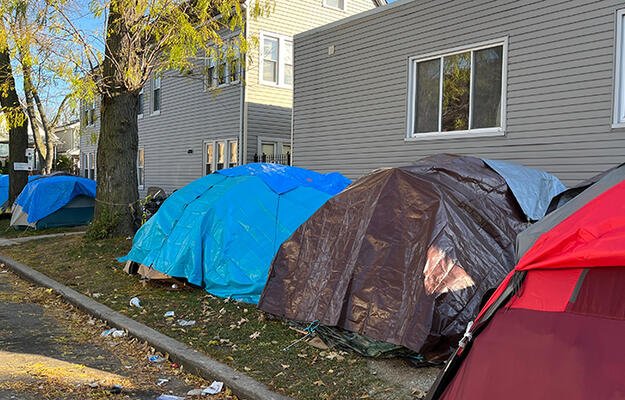
From Promise to Practice: Aligning Housing and Services to Support Survivors of Intimate Partner Violence
by Caroline Jones, MSW, Doorways for Women and Families President and CEO
The blog post and research on How Housing Matters focus on housing for survivors of intimate partner violence (IPV) and highlight the critical need to go beyond shelter in supporting survivors in overcoming abuse. Domestic violence and housing stability intersect in unique, multifaceted ways. Survivors from marginalized communities face even greater challenges as they navigate toward safety and stability. Promising emerging evidence shows what is working well, yet bringing these resources to all communities cannot be slow. Fully scaling and implementing survivor- and equity-centered approaches is crucial, and applying these approaches for all survivors will require housing and IPV providers to work together in new ways. Together we can address the concurrent and interwoven drivers of housing instability for survivors of violence.
Historically, approaches to ending homelessness and those for ending IPV have operated, at best, in parallel. Despite evidence that domestic violence is a leading cause of homelessness among women, youth, and families and that abuse and its impacts continue long after survivors leave relationships, very few survivor-centered housing options exist. But this is beginning to change. Ending homelessness for families and youth is now a national priority. In response to this shift, several IPV providers have developed promising models for safely and stably housing survivors while ensuring survivors have the support and empowerment necessary to move forward after abuse.
As more survivors summon the courage to seek safety, enabling service providers to implement and scale these strategies quickly is imperative. Housing is a critical unmet need for survivors. Doorways for Women and Families (Doorways) provides both homeless and IPV services, including supportive housing. For decades, Doorways has seen how survivors’ paths to safety and stability are cut short by limited alignment of resources and policies between the housing and IPV systems. Survivors face barriers to securing safe and permanent housing because of constrictive eligibility requirements, limited program options, and inflexible time limits. Survivor-informed housing practices are needed to address both homelessness and IPV beyond the emergency-shelter point of care.
Aligning policy-level leaders within the historically separate systems of Homeless Continuums of Care (CoCs) and IPV service providers has been fundamental to successful pilots (PDF). Our next step together—implementation and scaling—requires that we integrate our every resource—evidence-based strategies, systems of care, and funding—and how we measure success. In this stage, frontline staff, program leaders, and funders must align and integrate approaches along every point throughout these systems.
Implementing Evidence-Based Strategies to Meet Survivors’ Needs
To accomplish this integration, we must first acknowledge that survivors’ experiences of homelessness differ from other populations. Among these many differences is the financial havoc that abusive partners intentionally impose on survivors’ economic and housing stability to trap them in the relationship, including ruining their credit, stealing their money, destroying their property, and preventing them from working. The success of survivor-focused housing models thus far has fundamentally adapted to a survivor-centered approach that incorporates the core elements of Housing First and IPV practices.
The Domestic Violence Housing First model (DVHF) does this well and aligns with how Doorways has achieved success with our clients. This model includes three core elements: survivor- and trauma-informed mobile advocacy, flexible funding, and community engagement. The evaluation data show success in sustained housing, increased safety, improved health and well-being, and restored dignity for survivors.
Creating Comprehensive Systems of Care
To more widely implement successful models like DVHF, CoC and IPV systems of care must align on the ground level. Incorporating service providers in each of these systems is critical to ensuring that the successful, proven tenets of survivor-informed housing models are upheld in practice. Although models like DVHF have similarities to the Housing First approaches developed for other populations, the nuances of this approach must be adopted.
One such nuance is the approach to harm reduction. The Housing First model emphasizes harm reduction in supporting persons with self-risk behaviors, such as substance abuse. In DVHF, harm reduction occurs in the form of safety planning, which aims to reduce someone else’s harmful acts, not the survivor’s behaviors. Another nuance is language. In the DVHF model, staff are referred to as “advocates,” working with survivors to facilitate access to information, supports, and resources to empower survivors. Although several of these roles parallel those of the Housing First model’s “case managers,” upholding language that continually empowers survivors as they rebuild is essential.
Finally, it is well understood that the life experiences that commonly lead to homelessness induce trauma. Therefore, all Housing First models call for trauma-informed service delivery. In DVHF models, advocates must be well versed in trauma-informed care and the dynamics of abuse. Given that the impacts of trauma and abuse last long after survivors leave these relationships, advocates must constantly consider their implications in survivors’ navigation of housing, economic independence, custody, legal issues, immigration, and social supports. Incorporating this understanding into housing program eligibility, lengths of service, and practice will help survivors remain housed as these repercussions arise over time.
Funding and Measuring Success
To implement models like DVHF more widely, funding requirements and measures of success must better align. A recent study of IPV advocates highlights missed connections that limit our success; advocates noted that housing was one of “many moving parts” they were working on with survivors requiring equal or more attention, such as safety, economic issues, children’s needs, and trauma. Concurrently, for survivors from marginalized communities, additional hurdles of racial inequity, discrimination, immigration issues, fear of being outed, or rejection from their families or communities compound the issues they navigate. Progress, as we define it, is not linear and is often not measured by US Department of Housing and Urban Development or CoC homelessness and housing metrics. Studies point to the need for measures that capture impacts of critical supportive services paired with housing assistance—such as skill building, enhanced safety, and child and family wellness—to measure success in survivor housing programs.
Funding the DVHF model’s community engagement element and systems-level advocacy is critical. As Cris Sullivan, director of the Research Consortium on Gender-Based Violence at Michigan State University, and Linda Olsen, housing program coordinator at the Washington State Coalition Against Domestic Violence, write:
“Recognizing that one’s social and emotional well-being is not independent from community-level factors, advocates do not focus solely on working with individual survivors to improve their individual situations. They engage in a variety of efforts to create communities that hold offenders accountable, promote justice, and that provide adequate resources and opportunities for the survivors they work with and all community members (Sullivan 2016). This involves building and sustaining strong community partnerships, as well as working to change systems that are ineffective, inaccessible, or oppressive.”
Nationwide, survivor options for ongoing housing and support after fleeing abuse are limited. As a provider of both homeless and IPV services, Doorways sees the need to do better after survivors leave shelters. Widespread adoption across US communities can better serve survivors of IPV and better prevent cycles of abuse and instability by replicating what these pilots have taught us. We must continue until every survivor in every community has a clear, empowering path to long-term safety in a home free of violence.
Photo by Marcos Mesa Sam Wordley/Shutterstock


